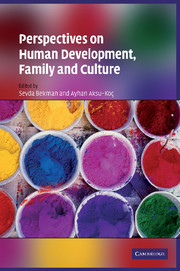Book contents
- Frontmatter
- Contents
- List of figures
- List of tables
- List of contributors
- Preface
- Foreword
- Selected international publications by Çiğdem Kağıtçıbaşı
- I Cultural and cross-cultural psychology: selected perspectives
- II Development in the family context
- III Culture and self
- IV Social change, family, and gender
- 13 One or two pathways to modernity? A systematic comparison of Kağıtçıbaşı's Model of Family Change and the Model of the Second Demographic Transition
- 14 Living together in culturally-plural societies: Understanding and managing acculturation and multiculturalism
- 15 Cultural continuity and discontinuity in Turkish migrant families: Extending the Model of Family Change
- 16 Values and attitudes of young people in urban Turkey: A further test of Schwartz's theory of values and Kağıtçıbaşı's Model of Family Change
- 17 Career development of professional women in Turkey
- V Induced change
- Epilogue
- Subject Index
- Author Index
- References
15 - Cultural continuity and discontinuity in Turkish migrant families: Extending the Model of Family Change
Published online by Cambridge University Press: 04 August 2010
- Frontmatter
- Contents
- List of figures
- List of tables
- List of contributors
- Preface
- Foreword
- Selected international publications by Çiğdem Kağıtçıbaşı
- I Cultural and cross-cultural psychology: selected perspectives
- II Development in the family context
- III Culture and self
- IV Social change, family, and gender
- 13 One or two pathways to modernity? A systematic comparison of Kağıtçıbaşı's Model of Family Change and the Model of the Second Demographic Transition
- 14 Living together in culturally-plural societies: Understanding and managing acculturation and multiculturalism
- 15 Cultural continuity and discontinuity in Turkish migrant families: Extending the Model of Family Change
- 16 Values and attitudes of young people in urban Turkey: A further test of Schwartz's theory of values and Kağıtçıbaşı's Model of Family Change
- 17 Career development of professional women in Turkey
- V Induced change
- Epilogue
- Subject Index
- Author Index
- References
Summary
In contributing to this volume in honor of Çiğdem Kağıtçıbaşı, we are acknowledging our indebtedness to her. Her seminal research and leading role as a cross-cultural psychologist have profoundly influenced our own involvement in cross-cultural psychology – and that of others working with us. Since our first meeting, when I conducted my Ph.D. research in Turkey under her supervision, I have tried to live up to her advice: make sense of what your data are telling you. What my data were telling me at the time was that achievement motivation for the Turkish participants in my research was a WE-thing rather than a ME-thing, as mainstream motivational literature would have it. Having started my research career at a time when cross-cultural psychology was virtually nonexistent in most psychology departments in Europe, there is another insight that I owe to her inspiring example. Good research, and in particular good cross-cultural research, is a WE-thing too. It is a joint endeavor, which connects researchers and research ideas across cultures, genders, and generations. The cross-cultural studies discussed in this chapter are no exception to this rule. Following in her footsteps, we feel fortunate to be part of the transmission of this “culture of relatedness” in cross-cultural research to future generations of psychologists.
The cross-cultural study of the family, as exemplified by Kağıtçıbaşı's (1989, 1996) seminal work, is crucial for our understanding of acculturative change in the context of international migration.
- Type
- Chapter
- Information
- Perspectives on Human Development, Family, and Culture , pp. 241 - 262Publisher: Cambridge University PressPrint publication year: 2009
References
- 15
- Cited by

